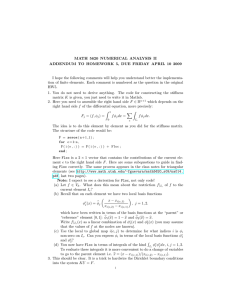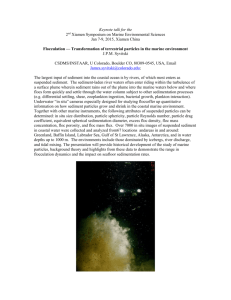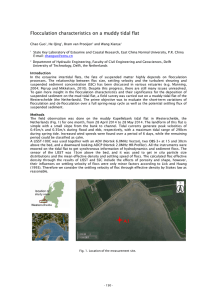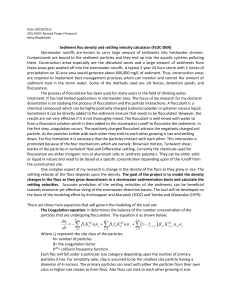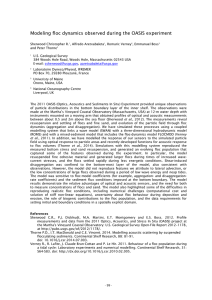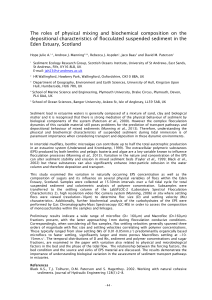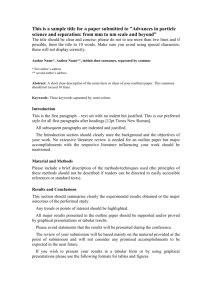Experimental investigation of flocculation in mixed sediments
advertisement
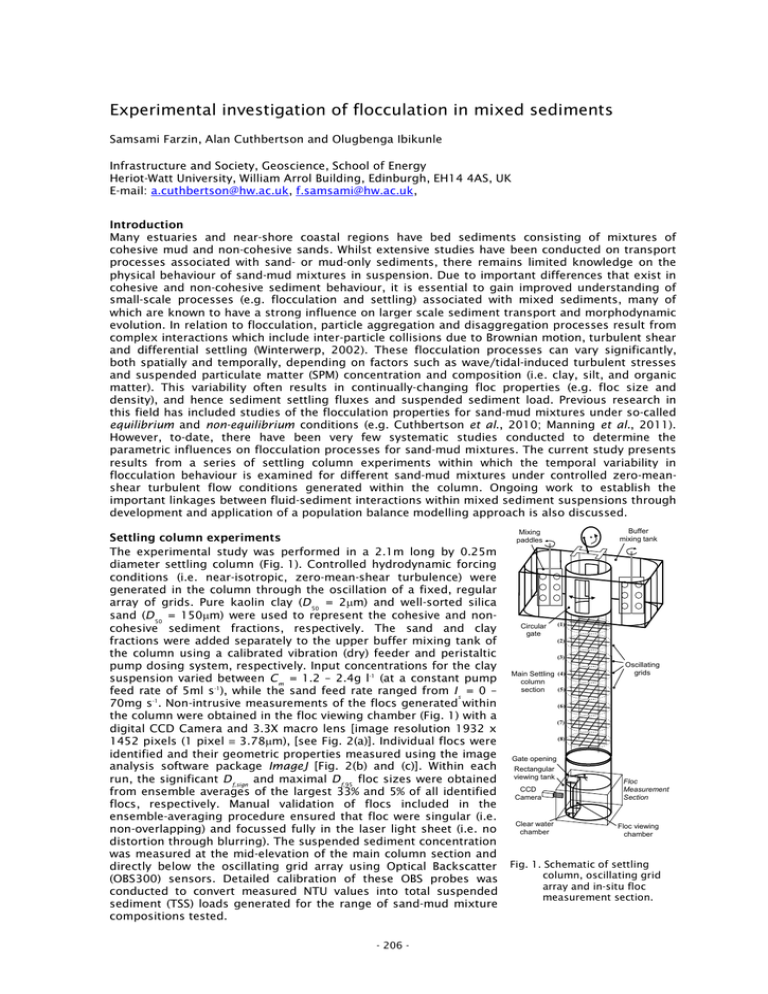
Experimental investigation of flocculation in mixed sediments Samsami Farzin, Alan Cuthbertson and Olugbenga Ibikunle Infrastructure and Society, Geoscience, School of Energy Heriot-Watt University, William Arrol Building, Edinburgh, EH14 4AS, UK E-mail: a.cuthbertson@hw.ac.uk, f.samsami@hw.ac.uk, Introduction Many estuaries and near-shore coastal regions have bed sediments consisting of mixtures of cohesive mud and non-cohesive sands. Whilst extensive studies have been conducted on transport processes associated with sand- or mud-only sediments, there remains limited knowledge on the physical behaviour of sand-mud mixtures in suspension. Due to important differences that exist in cohesive and non-cohesive sediment behaviour, it is essential to gain improved understanding of small-scale processes (e.g. flocculation and settling) associated with mixed sediments, many of which are known to have a strong influence on larger scale sediment transport and morphodynamic evolution. In relation to flocculation, particle aggregation and disaggregation processes result from complex interactions which include inter-particle collisions due to Brownian motion, turbulent shear and differential settling (Winterwerp, 2002). These flocculation processes can vary significantly, both spatially and temporally, depending on factors such as wave/tidal-induced turbulent stresses and suspended particulate matter (SPM) concentration and composition (i.e. clay, silt, and organic matter). This variability often results in continually-changing floc properties (e.g. floc size and density), and hence sediment settling fluxes and suspended sediment load. Previous research in this field has included studies of the flocculation properties for sand-mud mixtures under so-called equilibrium and non-equilibrium conditions (e.g. Cuthbertson et al., 2010; Manning et al., 2011). However, to-date, there have been very few systematic studies conducted to determine the parametric influences on flocculation processes for sand-mud mixtures. The current study presents results from a series of settling column experiments within which the temporal variability in flocculation behaviour is examined for different sand-mud mixtures under controlled zero-meanshear turbulent flow conditions generated within the column. Ongoing work to establish the important linkages between fluid-sediment interactions within mixed sediment suspensions through development and application of a population balance modelling approach is also discussed. Settling column experiments The experimental study was performed in a 2.1m long by 0.25m diameter settling column (Fig. 1). Controlled hydrodynamic forcing conditions (i.e. near-isotropic, zero-mean-shear turbulence) were generated in the column through the oscillation of a fixed, regular array of grids. Pure kaolin clay (D 50 = 2µm) and well-sorted silica sand (D 50 = 150µm) were used to represent the cohesive and noncohesive sediment fractions, respectively. The sand and clay fractions were added separately to the upper buffer mixing tank of the column using a calibrated vibration (dry) feeder and peristaltic pump dosing system, respectively. Input concentrations for the clay suspension varied between C m = 1.2 – 2.4g l-1 (at a constant pump feed rate of 5ml s-1), while the sand feed rate ranged from I s = 0 – 70mg s-1. Non-intrusive measurements of the flocs generated within the column were obtained in the floc viewing chamber (Fig. 1) with a digital CCD Camera and 3.3X macro lens [image resolution 1932 x 1452 pixels (1 pixel ≡ 3.78µm), [see Fig. 2(a)]. Individual flocs were identified and their geometric properties measured using the image analysis software package ImageJ [Fig. 2(b) and (c)]. Within each run, the significant D f,sign and maximal D f,95 floc sizes were obtained from ensemble averages of the largest 33% and 5% of all identified flocs, respectively. Manual validation of flocs included in the ensemble-averaging procedure ensured that floc were singular (i.e. non-overlapping) and focussed fully in the laser light sheet (i.e. no distortion through blurring). The suspended sediment concentration was measured at the mid-elevation of the main column section and directly below the oscillating grid array using Optical Backscatter (OBS300) sensors. Detailed calibration of these OBS probes was conducted to convert measured NTU values into total suspended sediment (TSS) loads generated for the range of sand-mud mixture compositions tested. - 206 - Buffer mixing tank Mixing paddles Circular gate (1) (2) (3) Main Settling (4) column (5) section Oscillating grids (6) (7) (8) Gate opening Rectangular viewing tank CCD Camera Clear water chamber Floc Measurement Section Floc viewing chamber Fig. 1. Schematic of settling column, oscillating grid array and in-situ floc measurement section. (a) (b) (b) (c) (c) 500 µm 100 µm 100 µm Fig. 2. (a) Image of settling kaolin flocs, (b)(c) enlarged images of individual flocs. Results and discussion Fig. 3 shows example time series plots of the total suspended sediment (TSS) variation measured at the two OBS positions, along with corresponding measurements of the significant D f,sign and maximal D f,95 floc sizes at specific times (note: error bars on D f,95 values represent the standard deviation in floc sizes used in the ensemble averaging). Results typically show that for mud-only runs [i.e. no sand fraction, Figs. 3.(a) and (c)], floc sizes attained are generally larger than those attained for equivalent sand-mud mixture conditions [i.e. equivalent mud concentrations C m and grid-generated shear rates G, Fig. 3(b) and (d)]. It is interesting to note that, at lower shear rates G, the TSS concentration within the column continues to increase over the duration of the run [Figs. 3.(a) and (b)], whilst it is shown to reach an equilibrium concentration under higher G values [i.e. TSS → 0.95 g l-1 at t > ~275min, Fig. 3(c)]. Equivalent floc measurements are shown to indicate a non-linear increase in D f,sign and D f,95 floc sizes with these TSS values, particularly noticeable for the sand-mud mixtures [Fig. 3(b) and (d)]. This may be due partly to (i) the temporal lag in response of flocculation processes to changes in TSS levels within the column (i.e. non-equilibrium conditions), and (ii) the additional effect of the sand fraction in inhibiting floc growth through differential settling processes and direct particle-floc collisions (Cuthbertson et al., 2010). In this regard, results from the ongoing development and application of a population-balance modelling approach, aimed at simulating the additional floc break-up mechanisms associated with sand-mud mixtures, will also be reported. Fig. 3. Time series plots of total suspended sediment (TSS) and measured floc sizes (D f,sign & D f,95 ) for runs with C m (g l-1): I s (mg s-1): G (s-1) of (a) 1.8:0:0.81, (b) 1.8:70:0.81, (c) 1.8:0:2.31, (d) 1.8:70:2.31. References Cuthbertson A., P. Dong and P. A. Davies. 2010. Non-equilibrium flocculation characteristics of fine-grained sediments in grid-generated turbulent flow. Coastal Engineering 57(4):447-460. Manning A.J., J.V. Baugh, J.R. Spearman, E.L. Pidduck and R.J.S. Whitehouse 2011. The settling dynamics of flocculating mud-sand mixtures: Part 1—Empirical algorithm development. Ocean Dynamics 61(2-3):311350. Winterwerp J.C. 2002. On the flocculation and settling velocity of estuarine mud. Continental Shelf Research 22:1339–1360. - 207 -
